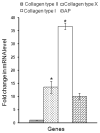An improved collagen scaffold for skeletal regeneration
- PMID: 20186736
- PMCID: PMC2891373
- DOI: 10.1002/jbm.a.32694
An improved collagen scaffold for skeletal regeneration
Abstract
Bone repair and regeneration is one of the most extensively studied areas in the field of tissue engineering. All of the current tissue engineering approaches to create bone focus on intramembranous ossification, ignoring the other mechanism of bone formation, endochondral ossification. We propose to create a transient cartilage template in vitro, which could serve as an intermediate for bone formation by the endochondral mechanism once implanted in vivo. The goals of the study are (1) to prepare and characterize type I collagen sponges as a scaffold for the cartilage template, and (2) to establish a method of culturing chondrocytes in type I collagen sponges and induce cell maturation. Collagen sponges were generated from a 1% solution of type I collagen using a freeze/dry technique followed by UV light crosslinking. Chondrocytes isolated from two locations in chick embryo sterna were cultured in these sponges and treated with retinoic acid to induce chondrocyte maturation and extracellular matrix deposition. Material strength testing as well as microscopic and biochemical analyzes were conducted to evaluate the properties of sponges and cell behavior during the culture period. We found that our collagen sponges presented improved stiffness and supported chondrocyte attachment and proliferation. Cells underwent maturation, depositing an abundant extracellular matrix throughout the scaffold, expressing high levels of type X collagen, type I collagen and alkaline phosphatase. These results demonstrate that we have created a transient cartilage template with potential to direct endochondral bone formation after implantation.
(c) 2010 Wiley Periodicals, Inc.
Figures







Similar articles
-
Biphasic calcium phosphate: a scaffold for growth plate chondrocyte maturation.Tissue Eng. 2006 Aug;12(8):2283-9. doi: 10.1089/ten.2006.12.2283. Tissue Eng. 2006. PMID: 16968168
-
Engineering endochondral bone: in vitro studies.Tissue Eng Part A. 2009 Mar;15(3):625-34. doi: 10.1089/ten.tea.2008.0051. Tissue Eng Part A. 2009. PMID: 18759672 Free PMC article.
-
Fractionated human adipose tissue as a native biomaterial for the generation of a bone organ by endochondral ossification.Acta Biomater. 2018 Sep 1;77:142-154. doi: 10.1016/j.actbio.2018.07.004. Epub 2018 Jul 4. Acta Biomater. 2018. PMID: 30126590
-
Culture of bovine articular chondrocytes in funnel-like collagen-PLGA hybrid sponges.Biomed Mater. 2011 Aug;6(4):045011. doi: 10.1088/1748-6041/6/4/045011. Epub 2011 Jul 11. Biomed Mater. 2011. PMID: 21747151
-
Recapitulating endochondral ossification: a promising route to in vivo bone regeneration.J Tissue Eng Regen Med. 2015 Aug;9(8):889-902. doi: 10.1002/term.1918. Epub 2014 Jun 11. J Tissue Eng Regen Med. 2015. PMID: 24916192 Review.
Cited by
-
Secreted Endothelial Cell Factors Immobilized on Collagen Scaffolds Enhance the Recipient Endothelial Cell Environment.Biores Open Access. 2016 Mar 1;5(1):61-71. doi: 10.1089/biores.2016.0003. eCollection 2016. Biores Open Access. 2016. PMID: 27057474 Free PMC article.
-
The influence of connective tissue growth factor on rabbit ligament injury repair.Bone Joint Res. 2017 Jul;6(7):399-404. doi: 10.1302/2046-3758.67.BJR.2016-0255.R1. Bone Joint Res. 2017. PMID: 28663339 Free PMC article.
-
Chiral Tartaric Acid Improves Fracture Toughness of Bioactive Brushite-Collagen Bone Cements.ACS Appl Bio Mater. 2020 Aug 17;3(8):5056-5066. doi: 10.1021/acsabm.0c00555. Epub 2020 Jul 6. ACS Appl Bio Mater. 2020. PMID: 32904797 Free PMC article.
-
Taking a deep look: modern microscopy technologies to optimize the design and functionality of biocompatible scaffolds for tissue engineering in regenerative medicine.J R Soc Interface. 2013 Jul 17;10(86):20130263. doi: 10.1098/rsif.2013.0263. Print 2013 Sep 6. J R Soc Interface. 2013. PMID: 23864499 Free PMC article. Review.
-
Evaluation and comparison of hydroxyapatite crystals with collagen fibrils bone graft alone and in combination with guided tissue regeneration membrane.J Indian Soc Periodontol. 2019 May-Jun;23(3):234-241. doi: 10.4103/jisp.jisp_386_18. J Indian Soc Periodontol. 2019. PMID: 31143004 Free PMC article.
References
-
- Pountos I, Jones E, Tzioupis C, McGonagle D, Giannoudis PV. Growing bone and cartilage. The role of mesenchymal stem cells. J Bone Joint Surg Br. 2006;88(4):421–6. - PubMed
-
- Newman AP. Articular cartilage repair. Am J Sports Med. 1998;26(2):309–24. - PubMed
-
- Tomihisa K, Tomoo M, Toshitaka T, Tomoyuki S. New bone formation around porous hydroxyapatite wedge implanted in opening wedge high tibial osteotomy in patients with osteoarthritis. Biomaterials. 2001;22(12):1579–1582. - PubMed
-
- Weiss P, Layrolle P, Clergeau LP, Enckel B, Pilet P, Amouriq Y, Daculsi G, Giumelli B. The safety and efficacy of an injectable bone substitute in dental sockets demonstrated in a human clinical trial. Biomaterials. 2007;28(22):3295–3305. - PubMed
-
- Verlaan JJ, Oner FC, Dhert WJ. Anterior spinal column augmentation with injectable bone cements. Biomaterials. 2006;27(3):290–301. - PubMed
Publication types
MeSH terms
Substances
Grants and funding
LinkOut - more resources
Full Text Sources
Other Literature Sources

